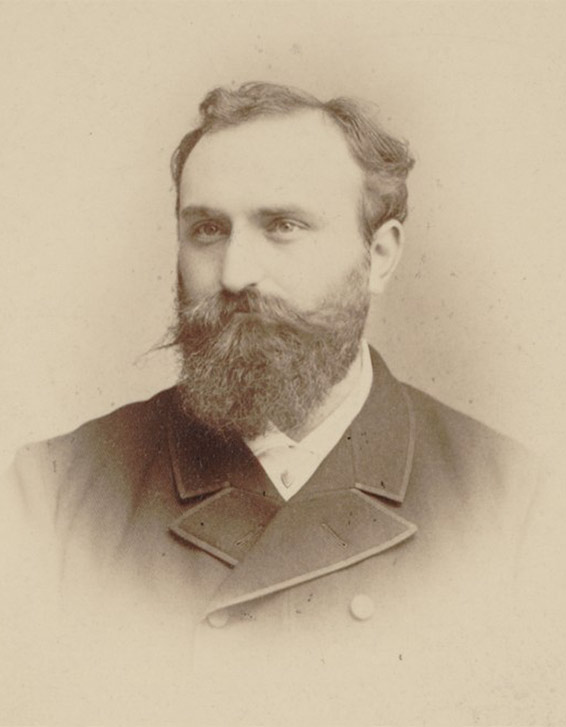Ernest Chausson (1855-1899)
Considering that Ernest Chausson’s life was relatively short (he died at 44) and that his first texts were written when he was not yet twenty, it can be said that he left an important number of writings. These include more than three hundred letters, a short story and a novel (written in his youth), three diaries, seven articles, and the libretto of Le Roi Arthus, his only opera. Seen as a whole, these texts are a source of great interest for those who wish to become better acquainted with the man and the artist in his personal growth and in the sources of his artistic calling. They show Chausson’s vocation gradually take form, first struck by doubts, and ultimately grow in confidence and substance, taking on aesthetic influences. Chausson’s writings offer an instructive picture of French musical life in the last quarter of the nineteenth century, and this is particularly true of his correspondence, which extends from the end of 1874 to June 1899, shortly before the composer’s accidental death. The different forms of Chausson’s writings offer a range of perspectives that create a dynamic portrait of an artist engaged with himself and his time.
Chausson never wrote for the public, apart from seven articles of music criticism devoted to Wagner’s Parsifal and his Ring Cycle, Boito’s Mefistofele, César Franck, and Fervaal, by his friend Vincent d’Indy. (A first article “Fervaal”, appeared in Le Mercure de France in April 1897 and a second, “Pour Fervaal” in L’Art libre of 23 June 1898). Unlike his peers Claude Debussy and Paul Dukas, he did not write a regular column in which he might have revealed his tastes or position. Surely his status as an artist of wealth spared from working as a freelance writer, an activity we know Debussy disliked. Nor was he drawn to musicological, historical, or theoretical subjects like Vincent d’Indy, Charles Bordes, Louis Bourgault-Ducoudray, and Maurice Emmanuel. Chausson came late to composing and long remained unsure of his technique and craftsmanship (he studied at the Conservatory with Jules Massenet and César Franck between 1879 and 1882). He did not pose as the leader of a school nor did he have the certitude of a professor. Modest and discreet, he also did not seek to publish his novelesque writings or his diaries during his lifetime as others did, such as Berlioz (Mémoires), (who Chausson revered), Gounod (Mémoires d’un artiste), or Camille Saint-Saëns (Harmonie et mélodie, École buisonnière).
To compare Chausson’s writings with those of his contemporaries is to remark that they are fundamentally intimate dialogues of personal or private motivation. They never bring up the political or religious topics that Chausson preferred to avoid.
To begin with, they are intimate dialogues with himself, such as Jacques, the autobiographical novel of his youth (the summer of 1876) marked with romanticism and idealism, and his three diaries of 1875, 1892, and 1896. The introspesction of these three periods of daily commentary are even more interesting because they come at three key moments in Chausson’s development as an artist. In 1875, he questions his future; in 1892, the first appreciative remarks on his music encouraged him to persevere, and in 1896 comes after the completion of Le Roi Arthus, which marked the liberation of his creativity. His correspondence contains exchanges with his inner circle, his family and his artist and musician friends, and reveals the composer’s character and questioning of his work.
In the end, only the libretto of Le Roi Arthus was destined for a public. As Jean Gallois remarked, it is always “a mirror of the composer himself, the crystallization of his thought and his creed” [Ernest Chausson, Paris, Fayard, 1994, p. 379]. This libretto, the versions of which are conserved at the Bibliothèque nationale de France [principally MS-8837-5, 6, and 9] required several drafts. Between the initial scenario of 1886 and the completion of the opera in 1895, it underwent many changes, from the general structure to its details. Chausson’s letters from this period regularly refer to the torments of this large-scale work.
Whether in his early novel, his diaries, his letters, or his articles, Chausson’s writings reveal a sincere and cultivated man who writes with ease and finesse. He belonged to a generation of musicians with multiple artistic capacities that hesitated for a time between several arts, as his journal of 1875, his “mute friend” as he called it, attests.
Most of Chausson’s correspondence has been published in journals [special issue of the Revue musicale of 1 December 1925; Vol. XLII of La Revue belge de musicologie, 1988; La Revue d’art, éditions CNRS, 1992], in a monograph of reference [Ernest Chausson by Jean Gallois, Fayard, 1994] and a special volume containing 243 letters by the composer [Écrits inédits collected by Jean Gallois and Isabelle Bretaudeau, éditions du Rocher, 1999] which also contains his three diaries (those of 1892 and 1896, shorter than the diary of 1875, are reproduced in extenso), as well as his novel Jacques.
Isabelle BRETAUDEAU
21/01/2018
Trans.: Chris Murray
Further reading
Barruel, Thérèse. « Maurice Denis et Ernest Chausson : Correspondance inédite et catalogue des œuvres de Denis ayant appartenu à Chausson », Revue de l’art, no 98, 1992, p. 66-76.
Chausson, Ernest. « Lettres inédites à Vincent d’Indy », dans La Revue musicale, Numéro spécial Ernest Chausson, 1er décembre 1925, p. 128-136.
Chausson, Ernest. « Lettres inédites à Paul Poujaud », dans La Revue musicale, Numéro spécial Ernest Chausson, 1er décembre 1925, p. 143-174.
Chausson, Ernest. « Lettres inédites à Henry Lerolle », dans La Revue musicale, Numéro spécial Ernest Chausson, 1er décembre 1925, p. 175-177.
Stockhem, Michel. « Lettres d’Ernest Chausson à Eugène Ysaÿe », Revue belge de musicologie, vol. 42, 1988, p. 241-272.
Van der Linden, Albert. « Deux lettres d’Ernest Chausson à Octave Maus », Revue belge de musicologie, vol. 3, no 1, 1949, p. 116-117.
